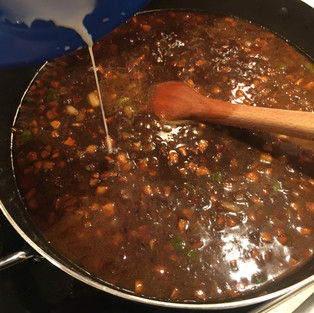Simple name, awesome taste!
- The Culinator (aka Jim)
- May 20, 2020
- 6 min read

This is my second favorite Korean dish and it is a realllllllly close second -- Jajangmyeon (Black Bean Sauce Noodles). The English name certainly doesn't do it justice because it is so darn tasty. While finding a recipe for this I did learn that there are many slight variations but they all have essentially the same ingredients - pork and vegetables cut up into small cubes and cooked with a special bean paste to make a thick, rick sauce.
First a little Korean lesson -- little because it's been over 20 years since I lived and worked there and I only learned a few things about the language. If you're Korean is better than mine, please add a comment to correct me. In the meantime, its my blog and my memories so I'll be as accurate as I can without doing any actual research! You'll find the word "myeon" spelled a couple of different ways (myon, meon, and even "men") but it is the same thing. Korean is a funny language that way. In my previous post I wrote a little about Hangul, the phonetically written Korean language. Because words sometimes have slightly different pronunciations you'll see them written slightly differently. I also learned to deal with that, while living there, when several of the Korean soldiers I work with were name "Lee" but the characters on their nametags were spelled differently. That is caused, in part, by sounds in Korean that we do not have in the English language. That's why we notice Koreans (and Japanese) can have difficulty pronouncing, for example, the "L" in English -- they never make that sound in their language. Well, that's a lot of background to point out that you're probably actually already familiar with the Korean word for noodles. Ever had Ramen noodles? Yep, it could also be Ramyeon. Ra would be "boiled" so Ramen is boiled noodles. For this particular dish, Jajang is black bean sauce so we end up with Jajangmyeon. If we put the same sauce on cooked rice we'd have...Jajangbap. There's your Korean lesson for the day, did you learn anything new?
Now, let's talk about making jajangmyeon! Going back to what I mentioned in my last post, Korean's don't use knives at the dining table. Because of that, the components of a dish (other than noodles) are cut up into small pieces during the food preparation. That's what took the most time preparing this dish too. A pound of pork sirloin chops were cut up into about 1/4" cubes. Then I cut up onions, zuchinni, potato, and mushrooms -- all into approximately 1/4" cubes. Finally, a cucumber was cut up into small shoestring type slices to be used as a garnish at the very end. Once the cutting was all done, then it was time to start cooking.
The "magic" ingredient you need to make this dish is the black bean paste (Chunjang). This Not having this ingredient is why it has taken me years (literally sine 1998) to try and make that. Thanks to the internet I found recipes online (one is linked at the bottom of this post) and Amazon to be able to purchase the paste itself! The jar isn't that actually that large -- I just got tired with trying to figure out how to shrink the photo in this blog editor!

Having never actually made this sauce before, nor having even seen it being made, the preparation of the sauce was a bit of an adventure. I suppose I could have watched a YouTube video but that would have taken away half of the fun! The paste is about the consistency of refried beans but a little stickier -- almost like a thin peanut butter? The instructions made no sense to me but I followed them and it was a really unique experience. I was making a double batch so I ended up with about 2/3 cup of sesame oil in my wok. The bean paste went into the hot oil (medium heat) and I was supposed to stir constantly.
I stirred and stirred and what was amazing and weird was that the paste never mixed with the oil! It moved around in the oil, it could be separated into two or three parts, but the oil never actually mixed in with the oil. It ended up essentially "poaching" the bean paste for about 2 minutes and then brown sugar was mixed in. The sugar quickly mixed in with the paste (more weirdness) and then after two minutes the paste was scooped out of the walk and set aside.
The next step was to cook all of the things we'd cut into little cubes earlier. First the pork was cooked until it was about 1/3 done. Next the zuchinni, onions, and potatoes went in and cooked for about 2 minutes until about 1/2 done. Last, the mushrooms went in and cooked for about 2 minutes. At this point everything looked pretty bland but the next step changed everything. The bean paste was added and stirred in and it turned into a beautiful brown sauce! At this point I was really excited because it looked very much like the sauce I remembered having in Korea. That is, it did until I did the next step in the recipe and added about two cups of chicken broth. At that point I thought I'd ruined everything because it turned into a thin brown soup.
I kept the faith though and kept following the recipe. The lid went on the wok and everything simmered for about minutes to finish cooking. By the end of that time...it still looked like brown soup. The next step made all of the difference to finish it up -- a cornstarch slurry went into the sauce and....kapow! It almost instantly thickened right up and gained a beautiful glossy sheen. It was one of the coolest things I've seen while cooking! By the way, I did learn that when adding the corn starch slurry it would be a good thing to kind of pour it slowly around the whole wok -- not just pour it into one spot like I did. It all worked out but it did initially form a very thick ball of sauce that took a little extra effort to stir in evenly.
While the sauce was finishing up I prepared a bowl of udon noodles and then the sauce went on top. Two or three ladles of sauce works for a fairly large bowl of noodles. The final garnish was the thin slices of cucumbers arranged on top. I served it sort of how you'd get it with one side dish of traditional kimchi.
There were a few moments when I wasn't sure I was headed down the right path but I'm glad I kept the faith. This turned out exactly how I remember having it in Korea. The funny thing is that I remember the little brown cubes in the sauce and I thought they were just potatoes. Having made it now I realize that the zucchini and pork and mushrooms and onions all take on the dark brown color from the sauce and are what actually gives the sauce much of its wonderful taste.
I'd mentioned earlier that in Korea the eating utensils consist of a long handled soup spoon and chopsticks. The spoon is used for eating soup and rice while the chopsticks are used for everything else, including noodles. Jajangmyeon is described as a comfort food that is often used for celebrating special occasions. It is also known that it isn't a very good dish to eat on a first date! Chopsticks with long udon noodles covered with a thick, dark brown sauce isn't one of the neatest things to eat. Its kind of a pick up a wad of noodles, shove them in your mouth and either slurp or bite them off. Its a good idea to have a napkin handy!
While I'm at it I'll share my chopstick story from when I lived in Korea. When we'd eat lunch in the Korean army base's dining hall, we'd walk in in a long line and grab our spoon and metal chopsticks from a couple of large cans at the end of the counter. Trying my best to learn and fit in with the Korean culture and customs I noticed that everyone would take three chopsticks, line them up, tap the ends on the counter, and put one back. So, for months I did the same thing and would take three sticks, tap them and put one back. One day I finally asked my Korean counterpart if we did this tapping ritual as a Buddhist tradition or something. He laughed at me and explained that there are two sets chopsticks that were slightly slightly different lengths. If you took three and tapped them on the table you could easily find the two that were the same and return the other. Ohhhhh.
I don't tap my chopsticks any more (they're all part of the same set) but I do still love Jajangmyeon. There are several recipes out there but here's a link to one if you'd like to try making it yourself (otherwise you need to find a nearby Korean restaurant and try it there!):
Bon appetit!




















































Commentaires